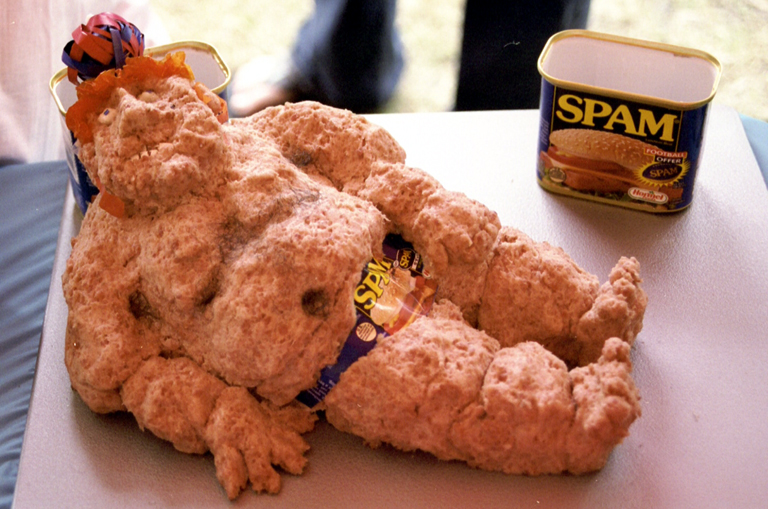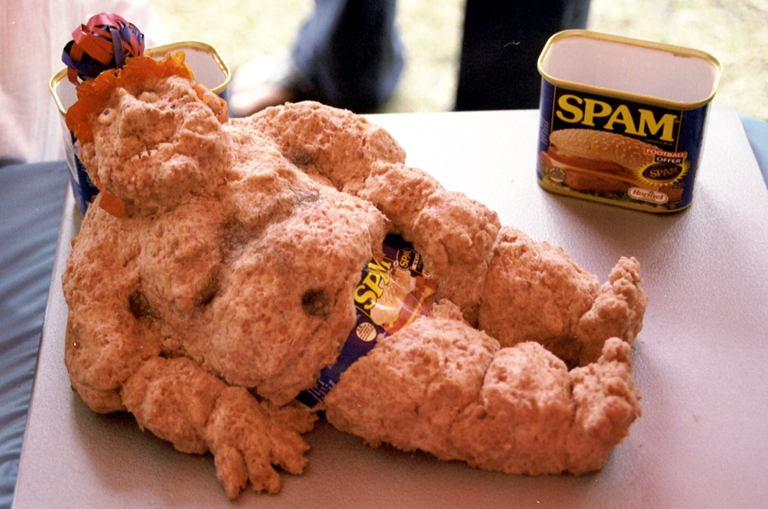I would like to welcome four new spam-followers to If all else fails…use a hammer. They joined yesterday and, while I know they won’t be reading any of my posts, at least they’re helping me towards my milestone of 100 followers, so good for them.
But that made me think, I haven’t written about spam in ages. To remedy that serious oversight I give you,
A Brief History of Spam
It all started with this guy:

Hang on! Sorry. I meant THIS guy:

Napoleon Bonaparte famously said an army marches on it’s stomach, referring to the need for proper logistics to ensure troops at the front line had enough food and other supplies to conduct the war. To that end, in 1795 he had a competition for people to invent a food-preservation technique that would help keep his troops fed. A confectioner (someone who makes sweets and pastries) named Nicolas Appert devised a method whereby he sealed food in a glass jar, covered the jars with canvas and then boiled them, cooking and sealing the food in its own juices. And thus canning was invented. (Yes, I know I said “glass jar”, but shortly thereafter another guy named Pierre Durand replaced the glass jars with tin cans which were easier to transport – you can’t expect Appert to think of everything. Anyway, Appert is the one who went down in history as the father of canning (not “glassing”) as he invented the overall technique. Google it if you don’t believe me.) Appert won the emperor’s praise and a bunch of cash, and the food processing industry was born.
Fast-forward a century or so, and say hi to Jay Hormel.

Jay was the son of George Hormel who started the Hormel Food Corporation and is the guy who invented SPAM®.
Hang on! Don’t start throwing stuff yet. THIS type of SPAM®:

During the First World War Hormel came up with the idea shipping deboned beef to the troops on the front line (so spare a thought for him next time you’re enjoying a McRib) and after the war started making the first canned hams, using Appert’s process.
He was also searching for a use for pork shoulder meat (I knew there was a reason I had uploaded a picture of a pig) – a part of pigs that wasn’t selling very well. He tried using additives to make the meat tastier and tried combining it with different parts of the pig, finally deciding on ham. Ground together and mixed with salt the two meats formed a pink paste (why does that make me think of Jamie Oliver?) which he squirted into a can and cooked using the Appert-process.
The product was eventually named Spam. The name was coined by Kenneth Daigneau, though no one’s sure exactly how he came up with it.

For some reason his new product enjoyed only moderate sales in the US, but that changed when WWII broke out. Hormel got a contract with the US government and tons of Spam was shipped to the UK where fresh meat was in short supply. When America joined the war it also became a standard ration of soldiers stationed in Hawaii and the other Pacific islands. By the end of the war the world had consumed 113 million cans of Spam.
Even though people seem to simultaneously love and hate Spam, it has remained popular around the world (though I can’t recall having come across it in SA), but nowhere so much than in the Pacific island region where Spam has just about become the national cuisine. In Hawaii you can get Spam at Burger King and McDonald’s and they even make something similar to sushi, called Spam musubi.

Spam is very salty and fatty, so it’s no surprise that the Pacific island region is also one of the most obese regions on earth – in 2008 eight of the world’s ten most obese countries were Pacific island nations, some of them with adult obesity as high as 95% of the population.
Not that that’s deterring the Spam-fans out there. If you find yourself in Hawaii during the last week of April, head over to Honolulu for the annual Spam Jam (where there will be Spam musubi if you’re interested). Shady Cove, Oregon has an annual Spam Parade and Festival. In Austin, Minnesota (where Spam was invented) there’s a Spam Museum where you can even get Spam collectibles (bet there’s a raging market for those)! Austin, Texas used to hold a Spamarama (complete with Spamalympics) around April Fool’s Day each year, but that hasn’t taken place since 2007 – they probably got sick from Spam ice cream or else the Spam sculptures came alive and ate them. Guess we’ll never know.
But what does all of this have to do with unsolicited electronic messages? There’s a fair amount of consensus that we should blame the guys from Monty Python.
This video is considered the first example of a conversation being “spammed”.
Some years later, on the first online bulletin boards and chat rooms, users would flood the screen with quotes from this skit or simply repetition of the word “spam” which, with the very low dial-up speeds of that era, would lead to a very frustrating online experience. This technique was especially used by insiders of a group to get rid of newcomers (which is also one of the main purposes of trolling, but more on that another day) or conversely by members of one group (e.g. Star Wars fans) invading the chatroom of another group (in this case, Star Trek fans) and “spamming” the group until the users gave up and left.
Over time “spamming” became the accepted term for users flooding the screen with large blocks of text, but also came to refer to excessive multiple posting, or posting the same message on multiple forums. Nowadays spam usually refers to unsolicited e-mails, but actually it appears in many different forms (with spam-liking and spam-following, as well as spam-comments common on WordPress.com (though we also get ham on WordPress)).
(According to Wikipedia, the first-ever spam-email was sent in 1978, when the term hadn’t even been coined. The first electronic chain letter was sent in 1988 and the first commercial spam incident was started in 1994.)

The rest, as they say, is history.
So, there you have the history of spam and of SPAM® stretching from Napoleon, through two world wars, to the early days of the internet.
Only one question still remains to be answered:
Source: The majority of the factual information in this post came from Sex, Bombs and Burgers – How War, Porn and Fast Food Created Technology As We Know It by Peter Nowak. (If I ever get around to finishing it there will be a review. Can’t promise that it’ll be before the end of this year, though.)


Haha. Loved the post! Entertaining and informative at the same time.
My favorite bit – spamming star trek forum till the users left. 😃
LikeLike
That bit I got off Wikipedia, so I can’t vouch for the factual accuracy. Personally I can’t see what the fuss is about – I love both Star Trek and Star Wars. Did I just commit some sort of blasphemy?
LikeLike
I wouldn’t know…. I haven’t watched either. Okay, now did I commit blasphemy? 😉
LikeLike
Just so long you don’t say you’ve never seen Doctor Who 😀
LikeLike
i will never be able to eat Spam again after seeing that sculpture… 🙂 Ewwww…
Actually I couldn’t eat Spam before. I’ve read diaries from NZ soldiers on Gallipoli in 1915, about the tinned pemmican they were given, the kind of revolting ancestor of spam that, every so often, they’d lob into the Turkish trenches. Usually the tin would be lobbed back with a note requesting real food next time.
Truth be told, I rather like bot followers. They are undemanding, never ‘unfollow’, and get the numbers up. Not entirely like the unwanted third cousin twice removed that you HAVE to invite to your wedding party… 😉
LikeLike
Never had Spam, but not particularly eager to try it either.
What bothers me most about these spam-followers are the hundreds of people who fall for their get-rich-quick scheme. On the other hand, it you’re too lazy to even google it, you probably deserve to be ripped off.
LikeLike
I spent the last 4 days going through my ‘followers’ pages, all of them, and I was surprised and downcast at the amount of spam I found. I even sent polite requests to several, asking them to remove themselves(one repiled with ‘ok,’ but hasn’t concurred). It’s the theft of time that’s meant for real readers. I spoke to WP and they said “hover on blog title(upper left), context menu Drops – Report this Content.” Great, now I need to waste another 4days. Oh dear, woe is me.
Your post is cool though, but the spam sculpture is disgusting. Happy summer. Cheers
LikeLike
The problem is most of them aren’t hosted on WP, so you can’t report them. They’re on a different platform that practises “viral blogging” – you make money for every person who joins the scheme via your blog. It’s no different from a pyramid scheme. They like and follow as many people as possible hoping to draw more people in (and you just have to go look at the comments on their “About” pages to see how effective this strategy really is. Luckily they tend to not leave comments that you’d need to moderate, which would take even more time.
The best strategy is to simply ignore them. After a while it gets easy to spot their blog URLs. Best way to keep track of your actual number of followers is to look at your average views.
Thanks for taking the time to read and comment on this one, though. It’s middle of winter over here (I’m in South Africa), but enjoy your summer…while it lasts (evil laugh)
LikeLike